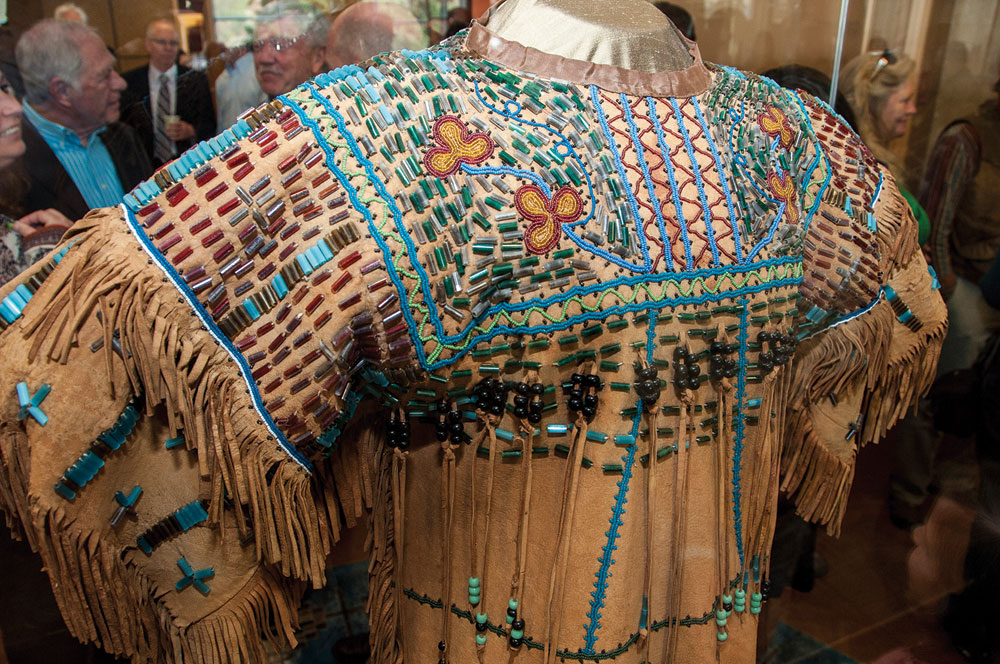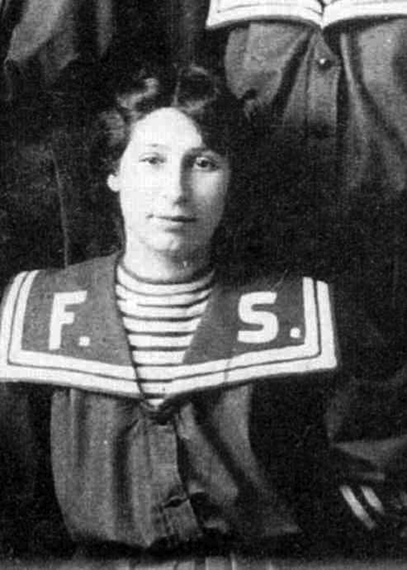- Editorial Offices
- 325 Brantly Hall
- Missoula, MT 59812
- (406) 243-2488
- themontanan@umontana.edu
- Icons By Maria Maldonado
Emma Sansaver has an incredible story—one of courage, tenacity, perseverance, and hard work.

Emma Sansaver has an incredible story—one of courage, tenacity, perseverance, and hard work. It’s been a source of inspiration and countless conversations all of Beverly Braig’s life.
You see, Sansaver—Braig’s paternal grandmother—was a member of the famous Fort Shaw girls’ basketball team that became world champions at the 1904 World’s Fair in St. Louis.
Now a part of her story has a home at UM, in the form of a dress fashioned and once worn by Emma, which is displayed in The Payne Family Native American Center. The dress is on loan to UM from Braig’s family, including cousins Patt Payne and Barbara Winters.
“Emma’s dress is a living piece of history,” says Braig, a 1963 graduate of UM who also served on the UM Foundation Board of Trustees. “I want it to be used as a teaching tool to inspire students—especially women—to come to school, stay in school, and make something of yourself. My grandmother certainly did.”
The story of the team is well-documented in books such as Full-Court Quest: The Girls from Fort Shaw Indian School, Basketball Champions of the World and the film Playing for the World: 1904 Fort Shaw Indian Girls’ Basketball Team.
When Sansaver arrived at the Fort Shaw Industrial Indian School in spring 1897, basketball was brand new. Drawing on skills learned from traditional Native American games, Sansaver and her teammates quickly picked up the sport and flourished.
The Fort Shaw squad often beat high school and college teams. It’s said that they even toppled the men’s teams from UM and Montana State University. In 1904, the girls received an invitation to play at the St. Louis World’s Fair and compete against any team that would play them.
To fund the trip to St. Louis, the girls wore handmade dresses and performed traditional Native dances during halftime of games, Braig says. It’s the dress that Emma wore during these performances that is now at UM.
The Fort Shaw team beat the St. Louis All-Stars 17-6 to become world champions. According to the St. Louis Post-Dispatch, the Montana squad was “more active, more accurate, and cooler than their opponents.”
Sansaver returned to Montana and married Ernest Simpson—Braig’s grandfather—in 1908. She had eight children but died in her thirties due to complications of giving birth to her ninth child.
“She had a tremendous impact on her children, even though she died at a young age,” Braig says. “I find it amazing that 110 years later we are still talking about Emma.”

The dress was passed down from Simpson’s father to Braig’s father, who then became its caretaker. It’s made of tanned leather and intricately decorated with beads and stitched prairie roses, which Braig credits to Sansaver’s roots in northeastern Montana. Sansaver was Métis—her mother was Chippewa-Cree and her father was French.
The dress was a focal point of family lore. Braig fondly recalls her father taking out the dress and proudly telling the story of Emma. The dress hung on a wall in Braig’s home until this past May, when it was put on public display at UM.
In preparation for the dedication ceremony, Cheyenne Laue, a doctoral student in UM’s anthropology program, was tasked with researching the dress and putting together an informational display.
Laue, whose expertise is in the anthropology of technology, admits ethnohistory isn’t her “bread and butter.”
“When I was approached about this project, I wondered why I was chosen,” Laue says. “But I thought it sounded interesting, and it was a chance to learn about something new.”
As soon as she started her research, the project suddenly took on a whole new meaning. It turns out that Laue attended Fort Shaw Elementary School as a second- and third-grader.
“I found myself in this sort of crazy, interesting, coincidental situation,” Laue says. “I had this personal connection. I thought back about all the time I spent at Fort Shaw, playing basketball—not being very good at it—but playing. And here all these years later I’m working on a project about that place and the amazing women who were there. It’s really cool.”
Laue may call it a coincidence, but Braig, who understands better than anyone the power the dress holds, thinks it’s much more than that.
“To me, it’s spiritual,” Braig says. “Emma’s spirit clearly is alive and working.”